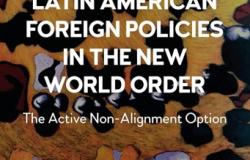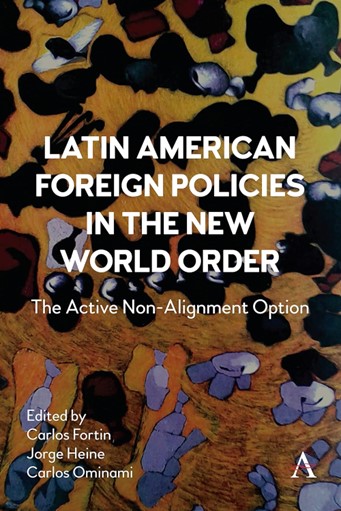Book Review - Latin American Foreign Policies in the New World Order: The Active Non-Alignment Option

Latin American Foreign Policies in the New World Order: The Active Non-Alignment Option, edited by Carlos Fortin, Jorge Heine, and Carlos Ominami. London: Anthem Press, 2023. 304 pp., £80 hardcover 9781839985720, £25 paperback 9781839991035, £25 e-book
The return of great power politics has rocked the international order. Although Latin America seems far from the epicenter of geopolitical earthquakes like Russia’s full-scale 2022 invasion of Ukraine and US-China tensions over Taiwan, the region has been affected by the aftershocks. Many commentators in Latin America connect these events to tectonic shifts away from US unipolarity – a development many welcome. However, the instability and uncertainty of the last few years suggest a multipolar order may not deliver unalloyed benefits to Latin America.
 This tension runs through the proposal for “active non-alignment” (ANA), advanced by senior statesmen Carlos Fortin, Jorge Heine, and Carlos Ominami. The trio made their case for ANA in a widely read 2020 article in Foreign Affairs Latinoamérica, gaining significant policy attention. In this 2023 book, these editors invite a who’s who of Latin American foreign policy figures to reflect on ANA, its antecedents, its applicability, and its potential consequences for the region’s position in a changing world.
This tension runs through the proposal for “active non-alignment” (ANA), advanced by senior statesmen Carlos Fortin, Jorge Heine, and Carlos Ominami. The trio made their case for ANA in a widely read 2020 article in Foreign Affairs Latinoamérica, gaining significant policy attention. In this 2023 book, these editors invite a who’s who of Latin American foreign policy figures to reflect on ANA, its antecedents, its applicability, and its potential consequences for the region’s position in a changing world.
The book’s twenty chapters range from personal reflections on the non-alignment of yesteryear to analyses of geopolitics, economic insertion, and regional cooperation. The book explores–and largely advocates–ANA as a policy option for nearly three dozen countries across the heterogeneous region of Latin America and the Caribbean. Given the wide scope of the chapters and the brevity of this review, I will approach the text synthetically, with limited discussion of individual contributions.
Given the chapters’ diversity, it is perhaps inevitable that the central concept of ANA is left loosely defined. There is more discussion of what ANA is not, and what ANA could offer, than of what precisely ANA is. The book’s contributors have varied readings and emphases regarding the central concept, and the editors seem to encourage that. ANA lacks the specificity of a “doctrine,” perhaps intentionally. As this suggests, ANA is better approached as a broad and malleable mindset for shaping Latin American engagement with the world.
Despite its varied conceptualizations and applications, the ANA proposal responds to a specific diagnosis–although not one all contributors share in its entirety. First, the editors see the world entering a “new Cold War” in which an updated version of non-alignment offers a way forward. Second, they see Latin American regionalism as broken, on the one hand, but also necessary and normatively desirable on the other. Third, they argue that the pandemic and its socioeconomic repercussions have underscored and worsened the debility of the region’s states. Facing these challenges, Latin America “has ceased to exist as a relevant international actor” (3). In response, ANA seeks to make Latin America matter globally by reinvigorating an emphasis on non-alignment, autonomy, and active diplomacy.
As the book acknowledges, ANA and its related proposals reflect a longstanding rhetorical emphasis on “autonomy” in Latin American foreign relations. The differences between “autonomy” and ANA, then, emerge from ANA’s diagnosis of today’s international context–which the editors see as a “new Cold War”. Indeed, the inclusion of several chapters that place ANA’s historical antecedents with the Non-Aligned Movement, Juan Perón’s “Third Position,” and other Cold War policy frameworks shed light both on what ANA might entail – and how such efforts may be received in Washington and elsewhere. Is this diagnosis sensible, and is ANA a fitting response?
If anything, the use of a “Cold War” framing suggests bipolarity. But many of the contributors explicitly reject this notion, envisioning the world through various multipolar formations and diffused structures of power. Surely this difference in diagnosis should matter a great deal for the prescription. It may, for instance, create greater space for regions and regional powers than bipolarity would. Potential allies and partners remain outside of competing blocs, rendering the meaning of “alignment” more ambiguous.
If one accepts US-China bipolarity as the dominant framing, then staying at the margins of a US-China conflict initially seems like a sensible proposal. But Latin American states’ ability to do so will vary tremendously. Geography matters: Mexico, Central America, and the Caribbean are profoundly tied to the US through a web of economic, social, and political connections. Issue-area matters, too. While Chinese approaches to sovereignty may appear more amenable to many Latin American leaders, it is hard to see the broadly progressive figures who favor ANA endorsing Chinese models of government and human rights at home.
In practice, though, ANA seems to be more about gaining distance from the historically dominant United States than it is driven by staying at arm’s length from China. In one sense, this makes sense. US influence has been, and remains, more deeply embedded in Latin American politics. The US-backed economic models of the 1990s and 2000s are seen as the primary culprit for the region’s recurring economic stagnation and weak state capacity.
China’s engagement is newer and narrower. Maintaining distance from China remains mostly limited to economic policy. However, if ANA is to bear fruit, the relationship with China will need to be revolutionized, perhaps to an even greater extent than the region’s ties with the United States. Many of the book’s economically focused chapters suggest that over the last two decades, engagement with China has contributed few possibilities for development outside old, destructive standbys of primary commodity exports. ANA’s goal of maintaining distance from the US clashes with political and economic realities for much of Latin America, precisely because the nature of the US engagement in the region is both broader and more multifaceted than China’s presence.
This is especially clear for Mexico and Central America, as Jorge Castañeda’s chapter makes clear. But even in the Southern Cone, where China’s economic weight is greatest, seeking distance from – as opposed to pursuing more egalitarian engagement with –the United States may backfire. The Latin America-China trade boom pushed South American exports to greater concentration in primary commodities, undermined intra-regional trade, and weakened manufacturing. It did nothing to advance Latin American ascendance in global value chains. For all its flaws, the region’s economic relationship with the United States and Europe is more diversified and includes higher value-added production.
The book’s second recurring topic is the parlous state of Latin American regionalism. Regionalism seems to be both a prerequisite for ANA’s success and one of the approach’s primary goals. Contributors point almost unanimously to regionalism as a “necessary condition” for improving Latin American international standing (Amorim, chap. 19). Yet, most argue that regionalism has had limited successes and is at a low ebb. This has implications for economic insertion, the subject of two of the book’s best chapters. Bárcena and Herreros (Chap. 11) and Rosales (Chap. 14) show the weakness of intra-Latin American manufacturing and joint Latin American participation in value chains. The exception is in North America, but with integration tied to the United States and Canada, not with other Latin American economies.
The book’s diverse assessments of the increasingly prominent ANA framework make it important reading for those trying to understand where Latin America will position itself in a changing world. Across the chapters, then, ANA operates as a container for a wide range of policies focused on promoting regional cooperation, autonomy-seeking, and more active international insertion. In framing and focus, ANA often seems to respond to a “new Cold War.” But a bipolar, conflictual world is not set in stone. Many aspects of today’s world radically diverge from the US-Soviet Cold War–including Latin American economic and political relations with the potential contenders. A look back at the first Cold War’s effects on Latin America suggest that the region should be wary about contributing to the co-constitution of the world into one defined by bipolar competition.
Dr. Tom Long is a Reader in International Relations in the Department of Politics and International Studies, at the University of Warwick.


